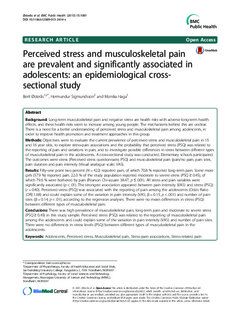| dc.contributor.author | Østerås, Berit | |
| dc.contributor.author | Sigmundsson, Hermundur | |
| dc.contributor.author | Haga, Monika | |
| dc.date.accessioned | 2016-09-09T11:45:54Z | |
| dc.date.accessioned | 2016-09-14T07:56:26Z | |
| dc.date.available | 2016-09-09T11:45:54Z | |
| dc.date.available | 2016-09-14T07:56:26Z | |
| dc.date.issued | 2015 | |
| dc.identifier.citation | BMC Public Health 2015, 15:1081 | nb_NO |
| dc.identifier.issn | 1471-2458 | |
| dc.identifier.uri | http://hdl.handle.net/11250/2407045 | |
| dc.description | This article is distributed under the terms of the Creative Commons Attribution 4.0
International License (http://creativecommons.org/licenses/by/4.0/), which permits unrestricted use, distribution, and
reproduction in any medium, provided you give appropriate credit to the original author(s) and the source, provide a link to
the Creative Commons license, and indicate if changes were made. The Creative Commons Public Domain Dedication waiver
(http://creativecommons.org/publicdomain/zero/1.0/) applies to the data made available in this article, unless otherwise stated. | nb_NO |
| dc.description.abstract | Background
Long-term musculoskeletal pain and negative stress are health risks with adverse long-term health effects, and these health risks seem to increase among young people. The mechanisms behind this are unclear. There is a need for a better understanding of perceived stress and musculoskeletal pain among adolescents, in order to improve health promotion and treatment approaches in this group.
Methods
Objectives were to evaluate the current prevalence of perceived stress and musculoskeletal pain in 15 and 16 year olds, to explore stress-pain associations and the probability that perceived stress (PSQ) was related to the reporting of pain and variations in pain, and to investigate possible differences in stress between different types of musculoskeletal pain in the adolescents. A cross-sectional study was conducted. Elementary schools participated. The outcomes were stress (Perceived stress questionnaire; PSQ) and musculoskeletal pain (pain/no pain, pain sites, pain duration and pain intensity (Visual analogue scale; VAS).
Results
Fifty-one point two percent (N = 422) reported pain, of which 70.8 % reported long-term pain. Some more girls (57.9 %) reported pain. 22.0 % of the study population reported moderate to severe stress (PSQ ≥ 0.45), of which 79.6 % were bothered by pain (Pearson Chi-square 38.47, p ≤ .001). All stress and pain variables were significantly associated (p < .01). The strongest association appeared between pain intensity (VAS) and stress (PSQ) (r = 0.40). Perceived stress (PSQ) was associated with the reporting of pain among the adolescents (Odds Ratio [OR] 1.68) and could explain some of the variation in pain intensity (VAS; β = 0.15, p < .001) and number of pain sites (β = 0.14, p < .01), according to the regression analyses. There were no mean differences in stress (PSQ) between different types of musculoskeletal pain.
Conclusions
There was high prevalence of musculoskeletal pain, long-term pain and moderate to severe stress (PSQ ≥ 0.45) in this study sample. Perceived stress (PSQ) was related to the reporting of musculoskeletal pain among the adolescents and could explain some of the variation in pain intensity (VAS) and number of pain sites. There were no differences in stress levels (PSQ) between different types of musculoskeletal pain in the adolescents. | nb_NO |
| dc.language.iso | eng | nb_NO |
| dc.publisher | BioMed Central | nb_NO |
| dc.rights | Navngivelse 3.0 Norge | * |
| dc.rights.uri | http://creativecommons.org/licenses/by/3.0/no/ | * |
| dc.title | Perceived stress and musculoskeletal pain are prevalent and significantly associated in adolescents : an epidemiological cross-sectional study | nb_NO |
| dc.type | Journal article | nb_NO |
| dc.type | Peer reviewed | nb_NO |
| dc.date.updated | 2016-09-09T11:45:54Z | |
| dc.source.volume | 15 | nb_NO |
| dc.source.journal | BMC Public Health | nb_NO |
| dc.identifier.doi | 10.1186/s12889-015-2414-x | |
| dc.identifier.cristin | 1283187 | |
| dc.description.localcode | © Østerås et al. 2015. This article is distributed under the terms of the Creative Commons Attribution 4.0 International License (http://creativecommons.org/licenses/by/4.0/), which permits unrestricted use, distribution, and reproduction in any medium, provided you give appropriate credit to the original author(s) and the source, provide a link to the Creative Commons license, and indicate if changes were made. The Creative Commons Public Domain Dedication waiver (http://creativecommons.org/publicdomain/zero/1.0/) applies to the data made available in this article, unless otherwise stated. | nb_NO |

